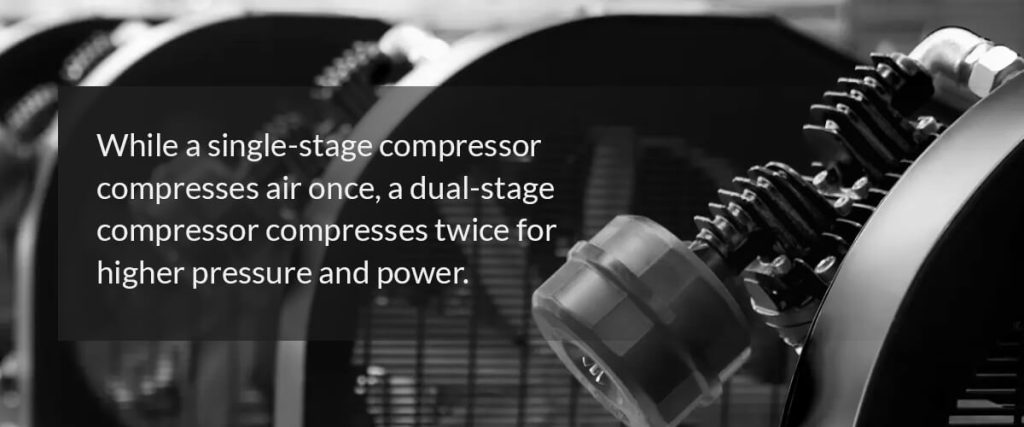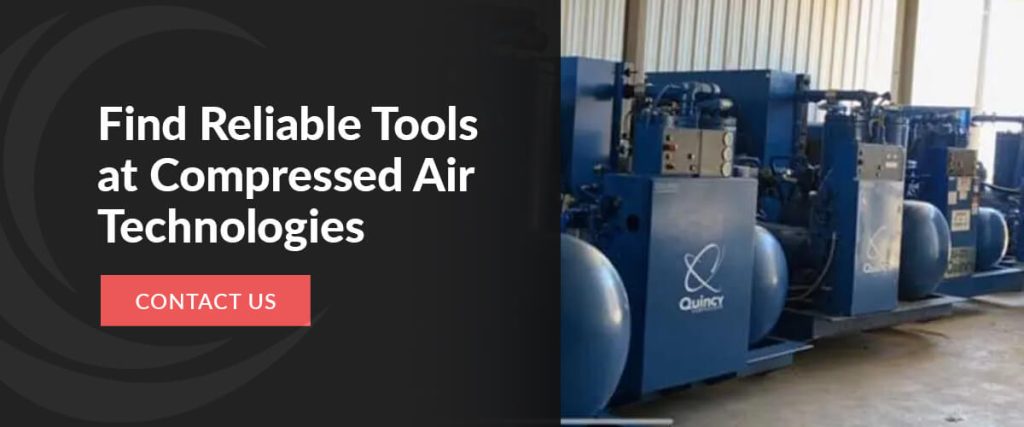

When choosing between a single-stage versus dual-stage air compressor, you will want to explore the differences between each model and the power each one provides. From woodworking to beverage manufacturing, both types of compressors can power various tools and machinery, making the manufacturing process faster and easier.
Also known as piston compressors, single-stage air compressors have pistons that draw air into the machine until it is sucked through a filter section. The air then passes through intake valves and into a cylinder, where a crankshaft rotates, and pistons push the air upwards. The piston helps compress the trapped air and force it through exhaust valves, which travel to a discharge tube and a check valve. Once the air enters a storage tank, it can stay until the user requires new air.
Two-stage air compressors — or dual-stage compressors — use a low-pressure, larger piston to draw in air. The air is sucked through a filter and passes the intake valve into a cylinder, where the crankshaft rotates, and a low-pressure piston pushes it upwards while compressing the air. The first compression also forces the air through a low-pressure exhaust valve which helps the air travel through an intercooler.
After cooling, the air travels to the high-pressure sides of the compressor, where it is drawn into a cylinder and compressed a second time. Once it passes the discharge tube and check valve, it remains safely in a storage tank until the user requires new air.

The main difference between single-stage versus two-stage air compressors is the number of times the air is compressed. While a single-stage compressor compresses air once, a dual-stage compressor compresses twice for higher pressure and power.
Single-stage compressors suck air into a cylinder where the trapped air is compressed. After moving to a storage tank, the air can be used as energy for various tools.
With a two-stage air compressor, rather than immediately going to a storage tank after compression, the air is sent to a smaller piston for the second round of compression. The double-pressurized air is also cooled before entering the storage tank, where the air can then be used as energy for high-powered tools and equipment.
A single-stage air compressor has many uses for providing energy for equipment. From woodworking tools to metalworking equipment, a single-stage compressor makes the production and manufacturing process more manageable. You can use single-stage air compressors in the following industries:
Woodworking often requires a wide variety of intensive tools to make furniture, fixtures or other wooden features. However, without the help of power tools, woodworking may require extensive physical work, stamina and hand-eye coordination. If you want to cut boards and drill holes evenly every time, you can use air-powered saws and drills to assist your process.
A single-stage air compressor powers these tools to help you achieve your goals in minutes rather than hours. A single-stage air compressor can also help power tools for the following tasks:
Any work involving metal is hard to accomplish without the proper tools. You need to cut, drill, mold and join pieces together, which is made easier with air-powered tools. Some tasks that might benefit from the help of air-powered tools include the following:
Two-stage air compressors are often used for high-powered tools and equipment. Air compressors power essential tools from automobile assembly and beverage manufacturing to aerospace and military equipment.
Constructing vehicles is a heavy-duty application that requires air-powered tools to save energy and assist in plant and repair shops. Automobile manufacturers may use two-stage compressors for the following tasks:
Companies use two-stage compressors during the beverage manufacturing process to power tools needed to produce massive amounts of soda, juice or alcohol. Beverage manufacturers may use air compressors for the following tasks:
When building aircraft, tanks or other military equipment, a two-stage air compressor helps generate enough power to assemble and finish each piece. Air compressors may also help with the following jobs:

At Compressed Air Technologies, we offer air systems, parts and lubricants and perform preventative maintenance and repairs whenever you need them. As the leaders of compressed air tools for over 30 years, our systems have run efficiently and smoothly, helping maintain your equipment’s reliability. Contact us today to speak to a representative and explore our compressed air products.